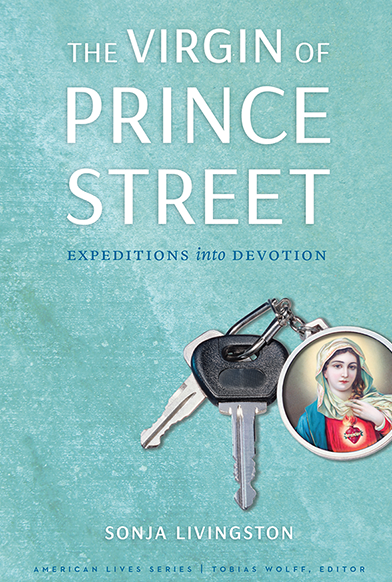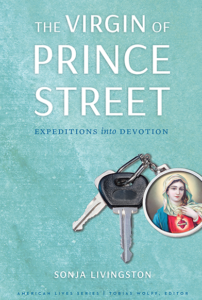by Elizabeth Felicetti
With Mary Sunday approaching, Episcopalians might be tempted to wade into the debate about the song “Mary Did You Know”: beautiful music, or mansplaining? A better observance might be checking out The Virgin of Prince Street: Expeditions into Devotion by Sonja Livingston, a Roman Catholic professor at Virginia Commonwealth University. Her collection of essays forms a narrative about returning to the Catholic church as an adult and noticing that one blue-cloaked statue of Mary that had been meaningful to her at her childhood church was no longer present, and her search to find it. This particular representation was less grand than others, with an “expression more pensive than sweet…. Queen of a working-class parish.” As various Catholic churches merged over the years, their statues migrated around. Livingston’s casual search becomes increasingly important as she explores her own spirituality. No spoilers about the end of her quest, but the book, part of the University of Nebraska’s American Lives series, makes ideal Advent reading.
When Livingston first showed up as an adult at her childhood church, she asked a priest who had come to welcome her what happened to the statue. He “looked suddenly weary and muttered something about not knowing while backing away from the pew,” which will evoke familiarity in clergy similarly burdened by artifacts in the churches they serve. At my current church, St. David’s, for example, we have two particle-board closets that cannot be replaced because they were built by a beloved long-ago person. I’ve been on both sides of treasured church heirloom stories, as my family donated a wooden altar to the church in which I grew up in honor of our late mother, which, as the church grew fancier, was first moved to a children’s classroom and eventually donated to another church, which we did not know until years later (demonstrating our infrequent attendance).
The introductory essay in The Virgin of Prince Street introduces Livingston’s non-traditional childhood in a progressive Catholic church that allowed altar girls years before Rome officially did. While she loved serving, Livingston’s faith was a skeptical one. She discovered the missing statue when making a quick pilgrimage to her childhood church following a candlelight vigil at the Presbyterian church of her in-laws. “The simple elegance of the service had been a good match for my head,” Livingston writes, “but the tangled mess of my heart longed for something else. ‘I need a statue of a saint,’ I joked, but [my husband and I] both understood that a statue was shorthand for many things.’”
Subsequent essays delve more deeply into Livingston’s faith. While her church was non-traditional, as a child she did not find adults who expressed doubt when she pressed them, for example, about the virgin birth. When someone asked Livingston after she returned to church whether she believed in God, Livingston, a writing teacher, was dismayed when she replied in the abstract—“I believe in goodness”—rather than using concrete images and stories as she would have instructed her students to do.
The Virgin of Prince Street unfolds in several locations, each containing opportunities for spiritual reflection. In Galway, Ireland, the Feast of Corpus Christi offers a chance to reflect on Eucharistic theologies and devotion to sacraments. Livingston asserts, “The reformers rightly sounded the alarm against an elaborate but empty spirituality, but veered so far in the other direction that they demonized devotion itself.” A Thanksgiving service in a prison allows her to explore her return to church with one sister who does not understand, and Livingston, loathe to argue, does not tell her sister how “the Mass somehow unclenches my heart.” Prison also encourages Livingston to explore Advent in a new way when she sees the significance of calendars to the incarcerated, who understand counting down days.
Livingston shares how sacraments and liturgies work on her as she describes how her knees buckled as she approached the altar for the first time after her return, leaving her pew “like exiting an aircraft.” Liturgies such as house blessings and confession provide further opportunities for spiritual struggling.
As the days slowly begin to lighten while Advent wanes, The Virgin of Prince Street: Expeditions into Devotion makes an intriguing companion.
The Virgin of Prince Street: Expeditions into Devotion
Sonja Livingston
Elizabeth Felicetti is the book reviews editor for Episcopal Café.



